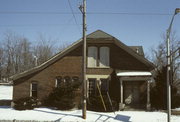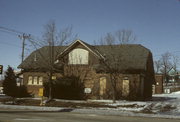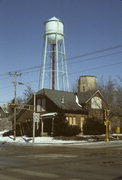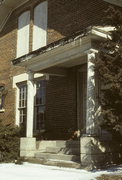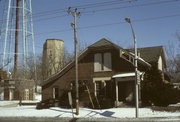| Additional Information: | A 'site file' exists for this property. It contains additional information such as correspondence, newspaper clippings, or historical information. It is a public record and may be viewed in person at the Wisconsin Historical Society, State Historic Preservation Office.
"The Beloit Pumping Station was constructed in 1885. It is a one and one-half story red brick building, originally 35 x 57 feet. Sanborn maps of 1890 and 1895 reveal that the building was divided into three rooms with the pumps housed in the westernmost room, the boilers in the middle room and the coal was stored in the easternmost room. A one story frame addition extended the building to the north. The style of the building is vernacular and utilitarian. A jerkin head roof with a large gable dormer set into the south slope covers the rectangular-shaped building. An arched window in the south gable has been covered with plywood, and an arched entrance beneath the gable has been brick filled. The 1908 Sanborn maps reveal that a one-story porch extended from this entrance and early pictures verify this.
The west entrance on the Pleasant Street facade has a shed-roof porch with pillars. A group of three small windows and two rectangular windows compose the fenestration on the first story of the west end. Beneath the jerkinhead is a pair of arched openings that once led to a balcony; these have been covered with plywood and the balcony removed.
On the east, vehicular doors have been added to allow entrance into the coal room. A small rectangular opening beneath the jerkinhead has been boarded in.
To the north, the frame addition showing in the 1890 Sanborn maps has been replaced by a brick addition. Photographs taken of the building in the late 1880s show a large smoke stack and sky lights on the roofline of the north facade. The smokestack is also revealed in the 1890 Sanborn maps as a brick structure at the north end of the boiler room. The smoke stack and the sky lights have been removed.
With the exception of remains of some piping in the pump room, there is no longer any machinery in the building. A cupola revealed in early 1900s photos has also been removed."
The Beloit Water Pumping Station was one of two major structures (see separate record for the Beloit Water Tower) associated with the development of the 19th century city water works. The following historical description is extracted from the "Water Works Structures of Rock County -- 19th century Thematic Nomination" to the National Register of Historic Places, submitted August, 1981:
"For the Beloit works, seven and a quarter mile of mains were laid out in the city in 1885, and as an incentive to the citizens to abandon their private wells, the first 100 patrons to subscribed to the service were given free service pipe to the curb stone. The system used over 850 tons of iron, including the pipes and machinery. 72 double hydrants were placed throughout the city on both the east and west sides of the Rock River for fire protection to the industrial as well as the residential sections of Beloit. The 63 foot Beloit water tower with the wooden tank placed on top, gave the gravitational pressure to the water flow, and direct pressure from steam operated Smith and Vale pumps, constructed in Dayton, Ohio, allowed a fire stream of two inches which could be thrown 130 feet high with 140 pounds of water pressure at the hydrant. The pumping station, located just southwest of the stone standpipe, provided water pressure to both sides of the Rock River in the City of Beloit. This meant a pipe had to be laid across the river from the east side, where the pumping station was located, to the west side. A second pumping station was built in 1894 on the west side of the river when the capacity of the one station could no longer provide adequate service.
Today the pump house is no longer in use and the company is looking for someone to rent the building. The exterior of the building has been altered, but the building appears to be in good repair.
The water tower, on the other hand, is falling into disrepair and is endangered because it has become a threat to public safety..." |
|---|

